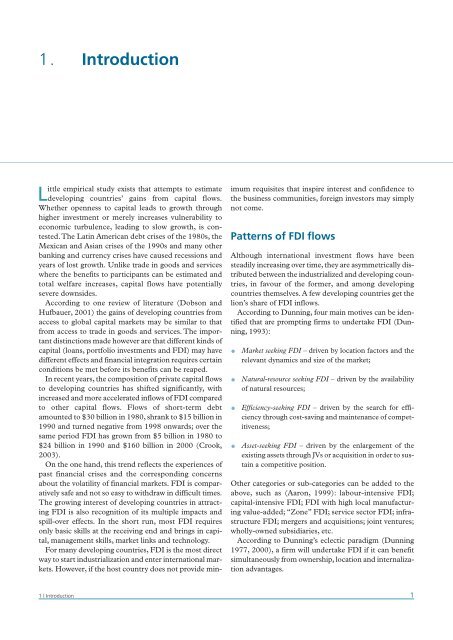Africa Foreign Investor Survey 2005 - unido
Africa Foreign Investor Survey 2005 - unido
Africa Foreign Investor Survey 2005 - unido
You also want an ePaper? Increase the reach of your titles
YUMPU automatically turns print PDFs into web optimized ePapers that Google loves.
1. Introduction<br />
Little empirical study exists that attempts to estimate<br />
developing countries’ gains from capital flows.<br />
Whether openness to capital leads to growth through<br />
higher investment or merely increases vulnerability to<br />
economic turbulence, leading to slow growth, is contested.The<br />
Latin American debt crises of the 1980s, the<br />
Mexican and Asian crises of the 1990s and many other<br />
banking and currency crises have caused recessions and<br />
years of lost growth. Unlike trade in goods and services<br />
where the benefits to participants can be estimated and<br />
total welfare increases, capital flows have potentially<br />
severe downsides.<br />
According to one review of literature (Dobson and<br />
Hufbauer, 2001) the gains of developing countries from<br />
access to global capital markets may be similar to that<br />
from access to trade in goods and services. The important<br />
distinctions made however are that different kinds of<br />
capital (loans, portfolio investments and FDI) may have<br />
different effects and financial integration requires certain<br />
conditions be met before its benefits can be reaped.<br />
In recent years, the composition of private capital flows<br />
to developing countries has shifted significantly, with<br />
increased and more accelerated inflows of FDI compared<br />
to other capital flows. Flows of short-term debt<br />
amounted to $30 billion in 1980, shrank to $15 billion in<br />
1990 and turned negative from 1998 onwards; over the<br />
same period FDI has grown from $5 billion in 1980 to<br />
$24 billion in 1990 and $160 billion in 2000 (Crook,<br />
2003).<br />
On the one hand, this trend reflects the experiences of<br />
past financial crises and the corresponding concerns<br />
about the volatility of financial markets. FDI is comparatively<br />
safe and not so easy to withdraw in difficult times.<br />
The growing interest of developing countries in attracting<br />
FDI is also recognition of its multiple impacts and<br />
spill-over effects. In the short run, most FDI requires<br />
only basic skills at the receiving end and brings in capital,<br />
management skills, market links and technology.<br />
For many developing countries, FDI is the most direct<br />
way to start industrialization and enter international markets.<br />
However, if the host country does not provide minimum<br />
requisites that inspire interest and confidence to<br />
the business communities, foreign investors may simply<br />
not come.<br />
Patterns of FDI flows<br />
Although international investment flows have been<br />
steadily increasing over time, they are asymmetrically distributed<br />
between the industrialized and developing countries,<br />
in favour of the former, and among developing<br />
countries themselves. A few developing countries get the<br />
lion’s share of FDI inflows.<br />
According to Dunning, four main motives can be identified<br />
that are prompting firms to undertake FDI (Dunning,<br />
1993):<br />
•<br />
Market seeking FDI – driven by location factors and the<br />
relevant dynamics and size of the market;<br />
•<br />
Natural-resource seeking FDI – driven by the availability<br />
of natural resources;<br />
•<br />
Efficiency-seeking FDI – driven by the search for efficiency<br />
through cost-saving and maintenance of competitiveness;<br />
•<br />
Asset-seeking FDI – driven by the enlargement of the<br />
existing assets through JVs or acquisition in order to sustain<br />
a competitive position.<br />
Other categories or sub-categories can be added to the<br />
above, such as (Aaron, 1999): labour-intensive FDI;<br />
capital-intensive FDI; FDI with high local manufacturing<br />
value-added; “Zone” FDI; service sector FDI; infrastructure<br />
FDI; mergers and acquisitions; joint ventures;<br />
wholly-owned subsidiaries, etc.<br />
According to Dunning’s eclectic paradigm (Dunning<br />
1977, 2000), a firm will undertake FDI if it can benefit<br />
simultaneously from ownership, location and internalization<br />
advantages.<br />
1 | Introduction<br />
1
















